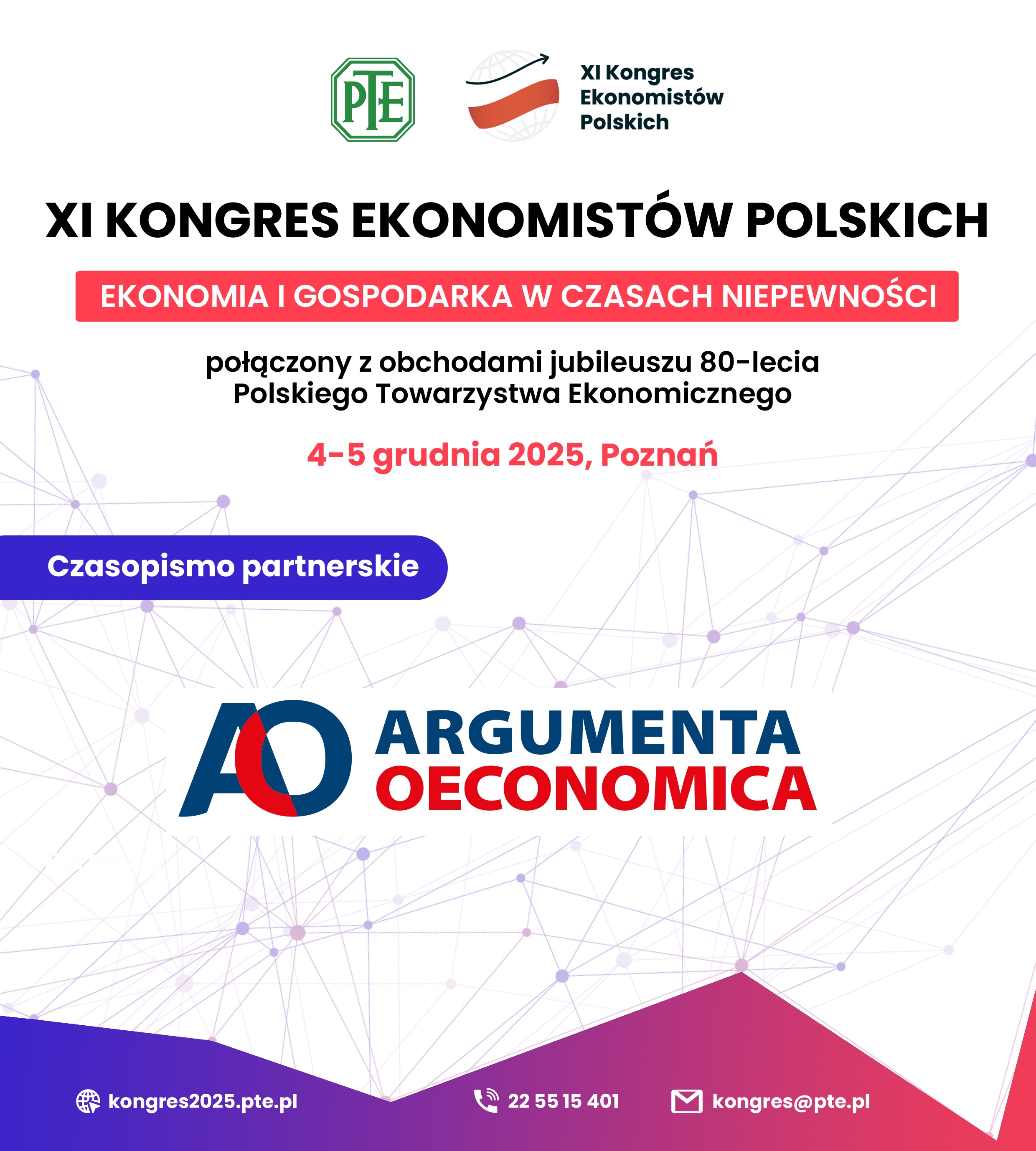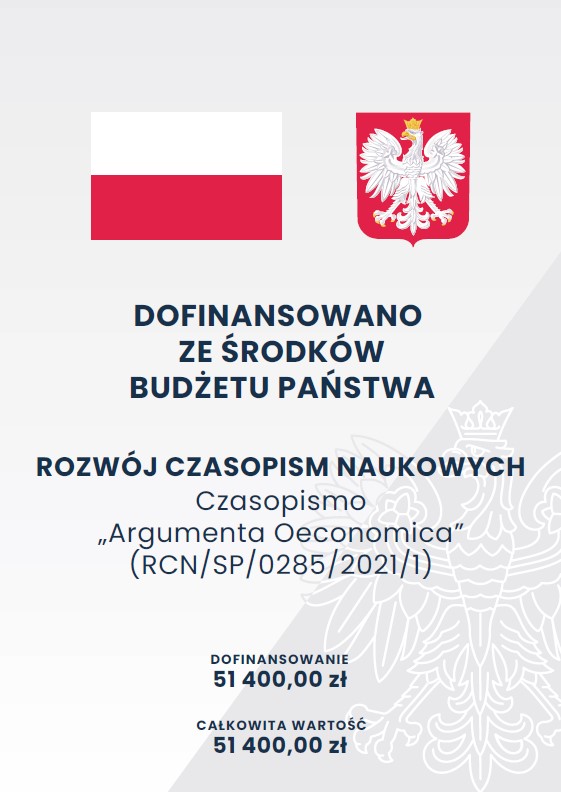The role of socio-demographics in the consciousness of sustainable consumption and the behaviour of young consumer
DOI:
https://doi.org/10.15611/aoe.2025.1.10Keywords:
consciousness of sustainable consumption, sustainable consumption, sustainable consumer, sustainable behavior, young consumersAbstract
Aim: This study investigated how the consciousness of sustainable consumption affects each of the consumption phases in terms of the different socio-demographic features of young consumers.
Methodology: To achieve the aim of this study, the structural equation modelling (SEM) was applied. The research data were obtained through a computer assisted web interview (CAWI).
Results: The results revealed not only that the consciousness of sustainable consumption has a signi-ficant effect on all three sustainable consumption phases, but also that socio-economic characteristics influence the strength of these relationships.
Implications and recommendations: The conclusions may be helpful to stakeholders involved in sustainable supply chains, and to institutions involved in the education and promotion of sustainable behaviour.
Originality/value: This study was the first to explore how the consciousness of sustainable consumption influences all stages of consumption among young consumers.
Downloads
References
Ajzen, I. (2011). The theory of planned behaviour: Reactions and reflections. Psychology & Health, 26, 1113-1127. https://doi.org/10.1080/08870446.2011.613995
Anh, P. T., Lan, N. T. N., Hanh, N. T. M., Huy, D. T. N., & Loan, B. T. T. (2020). Sustainable consumption behaviours of young people in the field of food and drinks: A case study. Journal of Security and Sustainability Issues, 9, 36-46.
Balderjahn, I., Buerke, A., Kirchgeorg, M., Peyer, M., Seegebarth, B., & Wiedmann, K. P. (2013a). Consciousness for sustainable consumption: Scale development and new insights in the economic dimension of consumer's sustainability. AMS Review, 3, 181-192. https://doi.org/10.1007/s13162-013-0057-6
Balderjahn, I., Peyer, M., & Paulssen, M. (2013b). Consciousness for fair consumption: Conceptualisation, scale development and empirical validation. International Journal of Consumer Studies, 37, 546-555. https://doi.org/10.1111/ijcs.12030
Balderjahn, I., Peyer, M., Seegebarth, B., Wiedmann, K. P., & Weber, A. (2018). The many faces of sustainability-conscious consumers: A category-independent typology. Journal of Business Research, 91, 83-93. https://doi.org/10.1016/j.jbusres.2018.05.022
Barr, S. (2003). Strategies for sustainability: Citizens and responsible environmental behaviour. Area, 35, 227-240. https://doi.org/10.1111/1475-4762.00172
Chin, W. W. (1998). The partial least squares approach to structural equation modeling. In G. A. Marcoulides (Ed.), Modern methods for business research (pp. 295-336). Lawrence Erlbaum Associates Publishers.
Chin, W. W., Mills, A. M., Steel, D. J., & Schwarz, A. (2016). Multigroup invariance testing: An illustrative comparison of PLS permutation and covariance-based SEM invariance analysis. In H. Abdi, V. Vinzi Esposito, G. Russolillo, G. Saporta, & L. Trinchera (Eds.), The multiple facets of partial least squares and related methods: PLS, 2014 (pp. 267-284). Springer Proceedings in Mathematics & Statistics 173.
Cohen, J. (1988). Statistical power analysis for the behavioral sciences, 2nd ed. Lawrence Erlbaum Associates.
DeVellis, R. F. (2016). Scale development: Theory and applications, Vol. 26, Sage.
Diamantopoulos, A., Schlegelmilch, B. B., Sinkovics, R. R., & Bohlen, G. M. (2003). Can socio-demographics still play a role in profiling green consumers? A review of the evidence and an empirical investigation. Journal of Business Research, 56, 465-480. https://doi.org/10.1016/S0148-2963(01)00241-7
Fischer, S., Stanszus, L., Geiger, S., Grossman, P., & Schrader, U. (2017). Mindfulness and sustainable consumption:
A systematic literature review of research approaches and findings. Journal of Cleaner Production, 162, 544-558. https://doi.org/10.1016/j.jclepro.2017.06.007
Fornell, C., & Bookstein, F. L. (1982). Two structural equation models: LISREL and PLS applied to consumer exit-voice theory. Journal of Marketing Research, 19(4), 440-452. https://doi.org/10.2307/3151718
Fornell, C., & Larcker, D. F. (1981). Evaluating structural equation models with unobservable variables and measurement error. Journal of Marketing Research, 18(1), 39-50. https://doi.org/10.2307/3150980
Franzen, A., & Vogl, D. (2013). Two decades of measuring environmental attitudes: A comparative analysis of 33 countries. Global Environmental Change, 23, 1001-1008. https://doi.org/10.1016/j.gloenvcha.2013.03.009
Geiger, S. M., Fischer, D., & Schrader, U. (2018). An integrative framework for the selection of relevant behaviours. Sustainable Development, 26, 18-33. https://doi.org/10.1002/sd.1688
Gericke, N., Pauw, J., Berglund, T., & Olsson, D. (2019). The sustainability consciousness questionnaire: the theoretical devel-opment and empirical validation of an evaluation instrument for stakeholders working with sustainable development. Sustainable Development, 27, 35-49. https://doi.org/10.1002/sd.1859
Hair, J. F. (2009). Multivariate data analysis: A global perspective, 7th ed. Prentice Hall.
Hair, J. F., Ringle, C. M., & Sarstedt, M. (2011). PLS-SEM: Indeed a silver bullet. Journal of Marketing Theory & Practice, 19(2), 139-152.
Hair, J. F. J., Hult, G. T. M., Ringle, C. M., & Sarstedt, M. (2017). A primer on partial least squares structural equation modeling (PLS-SEM). Sage.
Henseler, J., & Chin, W. W. (2010). A comparison of approaches for the analysis of interaction effects between latent variables using partial least squares path modelling. Structural Equation Modeling. A Multidisciplinary Journal, 17(1), 82-109. https://doi.org/10.1080/10705510903439003
Henseler, J., Hubona, G., & Ray, P. A. (2016a). Using PLS path modeling in new technology research: updated guidelines. Industrial Management & Data Systems, 116(1), 2-20. https://doi.org/10.1108/IMDS-09-2015-0382
Henseler, J., Ringle, C. M., & Sarstedt, M. (2016b). Testing measurement invariance of composites using partial least squares. International Marketing Review, 33(3), 405-431. https://doi.org/10.1108/IMR-09-2014-0304
Hwang, Y. Y., Jo, G. Y., & Oh, M. J. (2020). The persuasive effect of competence and warmth on clothing sustainable consumption: The moderating role of consumer knowledge and social embeddedness. Sustainability, 12, 2661. https://doi.org/10.3390/su12072661
IISD (2021). International Institute for Sustainable Development. Retrieved 21 June 2021, from: https://enb.iisd.org/consume/oslo004.html
Jacoby, J., Berning, C. K., & Dietvorst, T. F. (1977). What about disposition? Journal of Marketing, 41(2), 22-28.
Jain, S. K., & Kaur, G. (2006). The role of socio-demographics in segmenting and profiling green consumers: An exploratory study of consumers in Korea. Journal of International Consumer Marketing, 18(3), 107-146. https://doi.org/10.1300/J046v18n03_06
Jarvis, C. B., MacKenzie, S. B., & Podsakoff, P. (2003). A critical review of construct indicators and measurement model specification in marketing and consumer research. Journal of Consumer Research, 30(2), 199-218. https://doi.org/10.1086/376806
Kala, L. (2015). The environmental impact of singles’ consumer behaviour: Is the lifestyle of singles inevitably environmentally more damaging? Sociálni studia. Department of Sociology FSS MU, 3, 53-69.
Kim, S. Y, & Wolinsky-Nahmias, Y. (2014). Cross-national public opinion on climate change: the effects of affluence and vulnerability. Global Environmental Politics, 14(1). https://doi.org/10.1162/GLEP_a_00215
Kock, N. (2014). Advanced mediating effects tests, multigroup analyses, and measurement model assessments in PLS-based SEM. International Journal of e-Collaboration, 10(1), 1-13. https://doi.org/10.4018/ijec.2014010101
Kock, N. (2015). Common method bias in PLS-SEM: A full collinearity assessment approach. International Journal of
e-Collaboration, 11(4), 1-10.
Kock, N. (2021). WarpPLS user manual: Version 7.0. ScriptWarp Systems.
Kock, N., & Lynn, G. S. (2012). Lateral collinearity and misleading results in variance-based SEM: An illustration and recommendations. Journal of the Association for Information Systems, 13(7), 546-580.
Kreuzer, C., Weber, S., Off, M., Hackenberg, T., & Birk, C. (2019). Shedding light on realized sustainable consumption behaviour and perceived barriers of young adults for creating stimulating teaching–learning situations. Sustainability, 11, 2587. https://doi.org/10.3390/su11092587
Lim, W. M. (2022). The sustainability pyramid: A hierarchical approach to greater sustainability and the united nations sustainable development goals with implications for marketing theory, practice, and public policy. Australasian Marketing Journal, 30(2), 142-150. https://doi.org/10.1177/18393349211069152
Loo, W. H. L., Yeow, P. H. P., & Eze, U. C. E. (2013). Responsible consumption behaviour: A framework for acquisition, use & disposal of computers. PACIS.
Luchs, M., Naylor, R. W., Rose, R. L., Catlin, R. C., Gau, R., Kapitam, S., Mish, J., Ozanne, L., Phipps, M., Simpson, B., Subrah-manyan, S., & Weaver, T. (2011). Toward a sustainable marketplace: Expanding options and benefits for consumers. Journal of Research for Consumers, 19, 1-12.
Marsaglia G., Tsang W. W., & Wang J. (2003). Evaluating Kolmogorov’s distribution. Journal of Statistical Software, 8/18.
Muthu, S. S., Li, Y., Hu, J. Y., Mok, P. Y., & Din, X. (2012). Eco-impact of plastic and paper shopping bags. Journal of Engineered Fibers and Fabrics, 7(1). https://doi.org/10.1177/155892501200700103
Park, H. J., & Lin, L. M. (2020). Exploring attitude-behavior gap in sustainable consumption: Comparison of recycled and upcycled fashion products. Journal of Business Research 117, 623-628. https://doi.org/10.1016/j.jbusres.2018.08.025
Park, J., & Ha, S. (2014). Understanding consumer recycling behaviour: combining the theory of planned behaviour and the norm activation model. Family and Consumer Sciences Research Journal, 42(3), 278-291. https://doi.org/10.1111/fcsr.12061
Pena-Cerezo, M. A., Artaraz-Minor, M., & Tejedor-Numez, J. (2019). Analysis of the consciousness of university under-graduates for sustainable consumption. Sustainability, 11, 4597. https://doi.org/10.3390/su11174597
Piligrimiene, Ž., Žukauskaitė, A., Korzilius, H., Banytė, J., & Dovalienė, A. (2020). Internal and external determinants of consumer engagement in sustainable consumption. Sustainability, 12, 1349. https://doi.org/10.3390/su12041349
Rizkalla, N., & Erhan, T. P. (2020). Sustainable consumption behaviour in the context of millennials in Indonesia – can environmental concern, self-efficacy, guilt and subjective knowledge make a difference? Journal of Sustainable Business and Management Solutions in Emerging Economies, 25(3), 42-53. https://doi.org/10.7595/management.fon.2020.0001
Roberts, J. A. (1996). Green consumers in the 1990s: Profile and implications for advertising. Journal of Business Research, 36, 217-231.
Shapiro, S. S., & Wilk, M. B. (1965). An analysis of variance test for normality (complete samples). Biometrika, 52, 591-611.
Shaw, D., & Newholm, T. (2002). Voluntary simplicity and the ethics of consumption. Psychology & Marketing, 19 (2),
167-185. https://doi.org/10.1002/mar.10008
Starr, M. A. (2009). The social economics of ethical consumption: theoretical considerations and empirical evidence. The Journal of Socio-Economics, 38, 916-925. https://doi.org/10.1016/j.socec.2009.07.006
Suarez, E., Hernandez, B., Gil-Gimenez, D., & Corral-Verdugo, V. (2020). Determinants of frugal behaviour: the influences of consciousness for sustainable consumption, materialism, and the consideration of future consequences. Frontiers in Psychology, 11. https://doi.org/10.3389/fpsyg.2020.567752
Sun, J. J., Bellezza, S., & Paharia, N. (2021). Buy less, buy luxury: Understanding and overcoming product durability neglect for sustainable consumption. Journal of Marketing, 85(3), 28-43. https://doi.org/10.1177/0022242921993172
UNEP (2015). Sustainable consumption and production. A handbook for policymakers. Global Edition.
United Nations (2021). Retrieved May 15, 2021, from: https://sdgs.un.org/goals/goal12
Wetzels, M., Odekerken-Schröder, G., & van Oppen, C. (2009). Using PLS path modeling for assessing hierarchical construct models: guidelines and empirical illustration. Management Information Systems Quarterly, 33(1), 177-195. https://doi.org/10.2307/20650284
Zalega, T. (2019). Sustainable consumption in consumer behaviour of young Polish consumers. Studia Ekonomiczne, 383, 82-107.
Zrałek, J. (2018). Konsument wobec wyzwań zrównoważonej konsumpcji. Zrównoważone zachowania konsumenckie. Wydawnictwo Uniwersytetu Ekonomicznego w Katowicach.
Downloads
Published
License
Copyright (c) 2025 Agnieszka Szulc-Obłoza , Rafał Haffer, Michał Bernard Pietrzak

This work is licensed under a Creative Commons Attribution-ShareAlike 4.0 International License.
Accepted 2024-06-20
Published 2025-04-25








